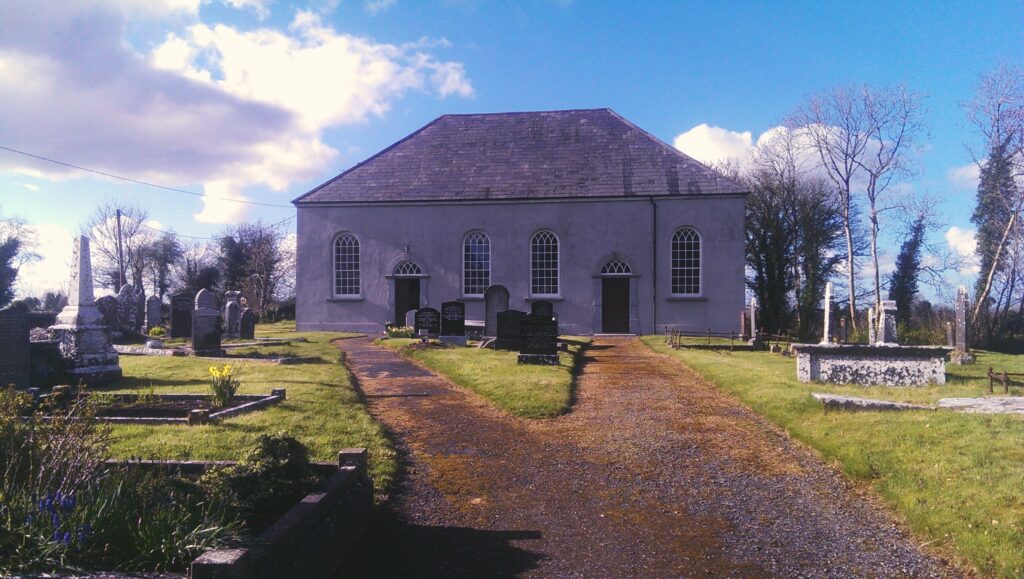On May 20, 1729, the George and Anne set sail from Dublin, Ireland for New Castle, Delaware, taking 180 immigrants to their new lives in colonial America.1 More than four months later, the survivors of that terrible voyage disembarked on Cape Cod, Massachusetts, several hundred miles from their intended destination. Some 80 passengers, many of them children, had died at sea.
Among the passengers were several members of the Thompson family, possibly including my seven-times great-grandfather James Thompson.2
The George and Anne was a chartered vessel. Many of the passengers were friends and neighbours of a man named Charles Clinton,3 of County Longford, Leinster Province, Ireland, who organized the trip. Many were members of Corboy Presbyterian Church near Edgeworthstown, County Longford.
Clinton’s diary noted the first hint of trouble came on the night of June 1 when a strong wind “loosened our bowsprit with hazard of our masts. June ye 2d we had a fair breeze on our westerly course, on the 3rdditto” Then, he reported, his daughter and his son “fell sick of the measles.”4
On June 5, a child died, and a second child died three days later. As the deaths continued over the following weeks, Clinton recorded them, but it is hard to determine exactly how many there were since he appears to have repeated some of the names. Clinton himself lost a son and a daughter, 12 members of the MacDowell family died, and James Thompson lost his wife and three children. Clinton did not note the causes; measles could have been a factor, while poor sanitation, lack of food and overcrowding no doubt led to disease. The desperation most people on board the vessel must have felt led directly to one death as a servant accompanying one of the passengers threw himself overboard and drowned. Several accounts of the voyage written by other families accuse the captain of trying to starve the passengers to death so he could steal their money.
In July, Clinton reported, gale-force winds from the northwest blew the ship far off course and, for a short time, it was becalmed off the north coast of Africa. Clinton did not say whether this was bad luck or poor navigation on the part of the captain.
When America finally came into view, it was October 4. Accounts of what happened next vary. One says the passengers had to pay a ransom to the captain before he would allow them to leave the ship, another says the passengers seized the captain and a crew member brought the ship to shore.5
The surviving passengers spent the winter on Cape Cod. They had originally intended to settle near Philadelphia, but instead some bought land a few miles west of the Hudson River, north of New York City. There they founded a community they called Little Britain in Ulster County. Today, some of their descendants still live in this area, now part of Orange County, New York.
There is some confusion about the identities of the Thompson family members on the voyage. Orange County genealogy researcher Elmire L. Conklin wrote, “The Charles Clinton diary listed James, Mary and William [Thompson] for a passage of four. The fourth passage was probably for the children of James [Jr.] and Mary, three of whom died on the voyage.”6
Most Thompson family historians have assumed that the William Thompson mentioned was the husband of Ann Jenkins. But Mrs. Conklin suggested this is incorrect. She suggested that the William Thompson mentioned in the diary was actually the brother of James Thompson Sr., who was also with the Clinton party, and that William Thompson and Ann Jenkins (my six-times great-grandparents) came to America later.7
Ann gave birth to daughter Sarah in February, 1729 so perhaps the family remained in Ireland that year rather than risk travelling with an infant. Also, the minister of their church gave them a reference letter to use in America, dated August 1737.8 It is more likely that they brought this letter with them than that they acquired it eight years after their arrival. If in fact they came to America on a ship other than the George and Anne, they made a lucky choice.
See also:
Janice Hamilton, “The Thompsons: from Scotland to Ireland and America,” Writing Up the Ancestors, https://www.writinguptheancestors.ca/2015/11/the-thompsons-from-scotland-to-ireland.html
Notes
- Jeffrey Clinton, “George and Anne Ship 1729 Passengers.” Genealogy.com, http://www.genealogy.com/forum/regional/countries/topics/ireland/17044/, posted July 5, 2000. List transcribed from Orange County Genealogical Society, vol. 3 no 4 (Feb. 1974), copied by Elizabeth S. Smith.
- Elmire L. Conklin, “The Two George Thompsons of Early Orange County, N.Y.,” Orange County Genealogical Society, vol. 21 no. 1 (May 1991), 9; Thompson vertical files. Orange County Genealogical Society, Goshen N.Y.
- Charles Clinton (1690-1773), was of English descent but was born in Ireland where his grandfather, a military officer, had been given land. One Thompson source says he was a cousin of the Thompsons, but I have not confirmed that. Once settled in New York, Clinton became a farmer, justice of the peace and militia colonel. He was the father of George Clinton, who served as Vice President of the United States from 1804 to 1812, and grandfather of DeWitt Clinton, a New York politician who was instrumental in the construction of the Erie Canal. Leslie Stephen, editor. Dictionary of National Biography, vol. XI, New York: MacMillan & Co., 1887, 91. https://books.google.ca, accessed Nov. 21, 2015.
- Thomas J. Barron, “Presbyterian Exodus, Co. Longford, 1729,” http://www.from-ireland.net/presbyterian-exodus-1729-longford/; article originally appeared in Breifne, no. 18 (1977-78), 253; accessed Nov. 6, 2015.
- Fergus D. H. MacDowall and William L. MacDougall. The MacDowalls, Clan MacDougall Society of North America Inc., 2009, 60; https://books.google.ca, accessed Nov. 21, 2015.
- Conklin, “The Two George Thompsons of Early Orange County, N.Y.”
- Ibid.
- “Thompson Genealogy (also Hudson and Duryea)” Orange County Genealogical Society, vol. 8 no. 4 (Feb. 1979), 30. Thompson vertical files. Orange County Genealogical Society, Goshen N.Y.

